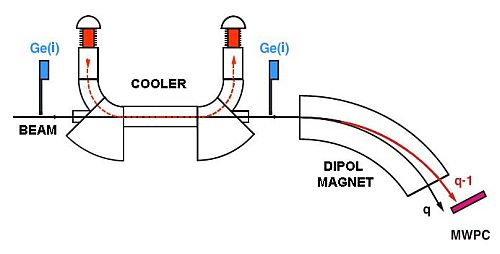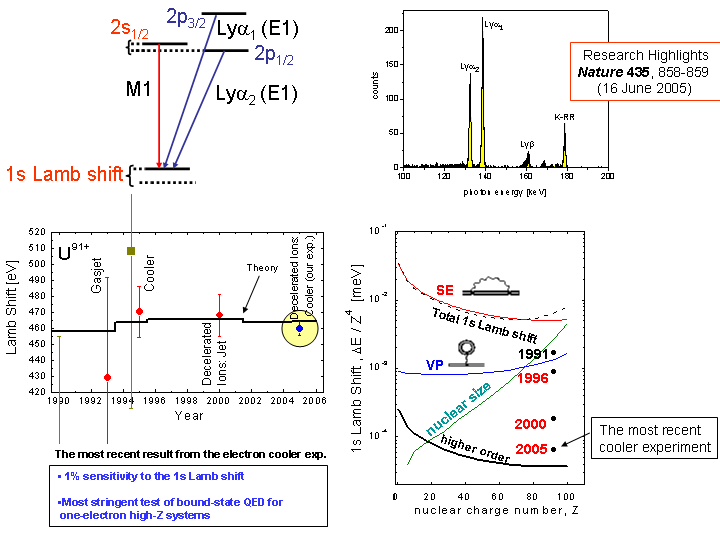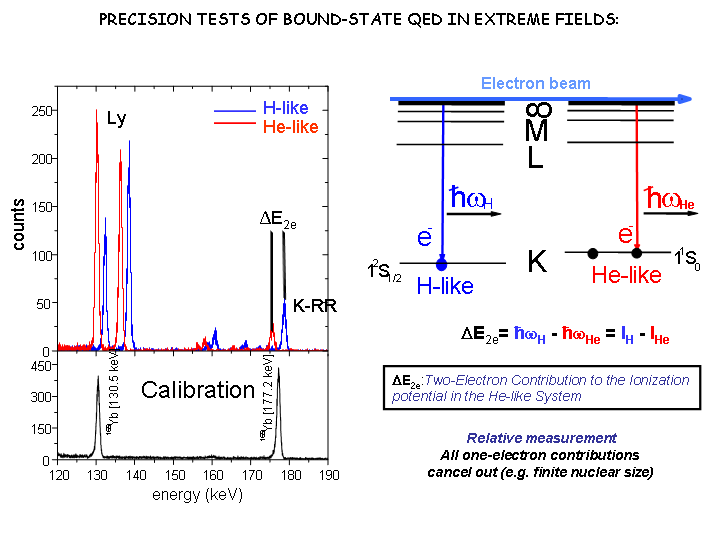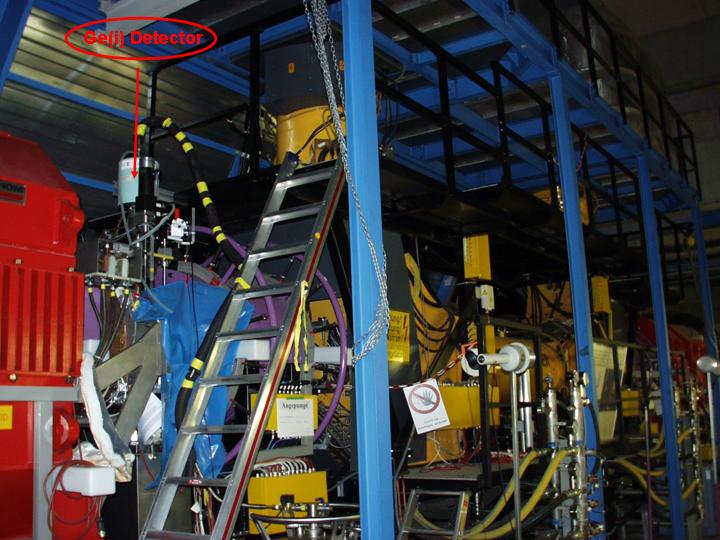Lamb Shift Measurements at the ESR Electron Cooler

Typical experimental setup for X-ray spectroscopy experimentens at the ESR electron cooler: X-Ray detectors are located at angles of approximatly 0 and 180 degree with respect to the ion beam axis. Like at the gas target, a particle detector after the next dipole magnet allows for coincidence measurements.
Topic 1:
Precision Measurement of the Ground-State Lamb Shift in H-like Uranium

Since, in our experiments the ground state transitions in H-like uranium have been measured at the same time, the topic of the one-electron Lamb shift in the high-Z regime is addressed in addition. The experiment was carried out by utilizing for the first time a combination of the deceleration technique of the ESR and the 0 deg spectroscopy at the electron cooler, thus, considerably reducing the uncertainties associated with Doppler corrections. This allowed us to determine the ground-state Lamb shift in hydrogenlike-uranium (U91+) from the observed x-ray lines with an accuracy of 1%. The present result (459.8 eV ± 4.6 eV) is about 3 times more precise than the most accurate value available up to now and provides the most stringent test of bound-state quantum electrodynamics for the fundemantal (one-electron) atomic systems in the strong-field regime.
COMING SOON:Outlook about FOCAL
Topic 2:
The Two-electron Contribution to the Ground-state Binding-energy in He-like Uranium

The aim of this investigation is to measure precisely the two-electron contribution to the ionization potential in He-like uranium of 2.2 keV with an accuracy of better than 5 eV. At this level, twoelectron second-order QED effects are calculated to contribute and therefore, such an experimental study would therefore provide a unique probe of higherorder QED corrections (in alpha) in the domain of highZ ions. For the first experiment, the setup available at the electron cooler section was used (see above). There, the xrays emitted via RR of the cooler electrons into the ground state of the bare or Hlike ions can be detected by a solid state detector which views the interaction region at an observation angle close to 0 degree. Because the key feature of the experiment is a relative measurement of RR into the Kshell of initially bare and Hlike uranium (see the picture above), we changed during the experiment three times between the two charge states. Compared to a simultaneous storage of both charge states, also possible at the ESR, this applied method has the advantage to allow us to measure the xray emission in coincidence with the downcharged ions by using a particle detector located behind the next dipole magnet (compare scheme of the experimental setup displayed below). In particular the experiment benefits from the recent established deceleration technique. At low energies, all uncertainties associated with Doppler corrections are strongly reduced compared to highenergy beams. Also, for decelerated ions the bremsstrahlung intensity caused by the cooler electrons is strongly reduced (due to the comparably small cooler voltage of 27 kV and current of 100 mA). Consequently, very clean conditions for xray spectroscopy are present at the cooler section. Compared to the pioneering investigations conducted at the superEBIT in Livermore, in our experiment, we were able to substantially improve the statistical accuracy and extend studies to the higher-Z regime. Moreover, our result has already reached a sensitivity on specifiic two-electron QED contributions. Our value agrees well with the most recent theoretical predictions within the experimental uncertainty. In addition, we like to note that similar to the superEBIT experiment possible sources of systematic errors are essentially eliminated and the result is limited only by counting statistics.
References:
A. Gumberidze,
Th. Stöhlker et al.
GSI Scientific Report 2001
Link
A. Gumberidze,
Th. Stöhlker et al.
GSI Scientific Report 2002
Link
Experimental studies of the ground state QED corrections in H- and He-like uranium
A. Gumberidze
PhD Thesis (2003)
Link
Electron-electron interaction in strong electromagnetic fields: The two-electron contribution to the ground-state energy in He-like uranium
A. Gumberidze, T. Stöhlker, D. Banas, K. Beckert, P. Beller,
H.F. Beyer, F. Bosch, X. Cai, S. Hagmann, C. Kozhuharov, D. Liesen,
F. Nolden, X. Ma, P.H. Mokler, A. Orsic-Muthig, M. Steck, D. Sierpowski, S. Tashenov,
A. Warczak, and Y. Zou
Physical Review Letter 92, 203004 (2004)
doi:10.1103/PhysRevLett.92.203004
Quantum Dynamics at Strong Electric Fields:
The Ground State Lamb Shift in Hydrogenlike Uranium
A. Gumberidze, Th. Stöhlker, D. Banas, K. Beckert, P. Beller, H.F. Beyer,
F. Bosch, S. Hagmann, C. Kozhuharov, D. Liesen, F. Nolden, X. Ma, P.H. Mokler,
M. Steck, D. Sierpowski, S. Tachenov
Physical Review Letter 94, 223001 (2005)
doi:10.1103/PhysRevLett.94.223001
Talks & Posters:
Poster - X-ray
Transitions for Decelerated Bare and H-like Uranium Ions Studied at the
ESR Electron Cooler
Link
Talk - X-ray transition studied for decelerated bare and H-like
uranium ions at the ESR electron cooler
Link
Links:
Precision Tests of Strong Field QED
(Part of this Page)
Pictures:

